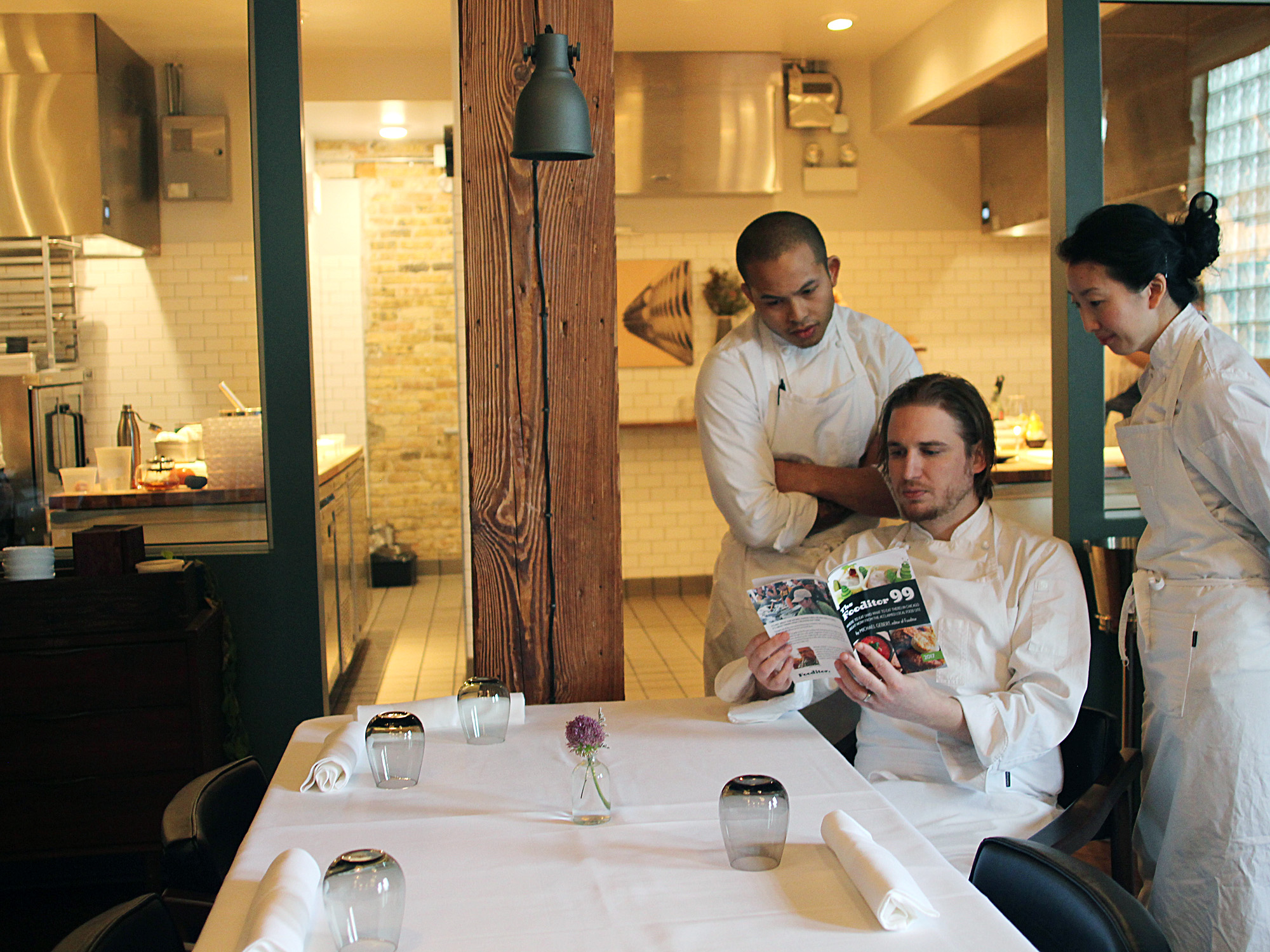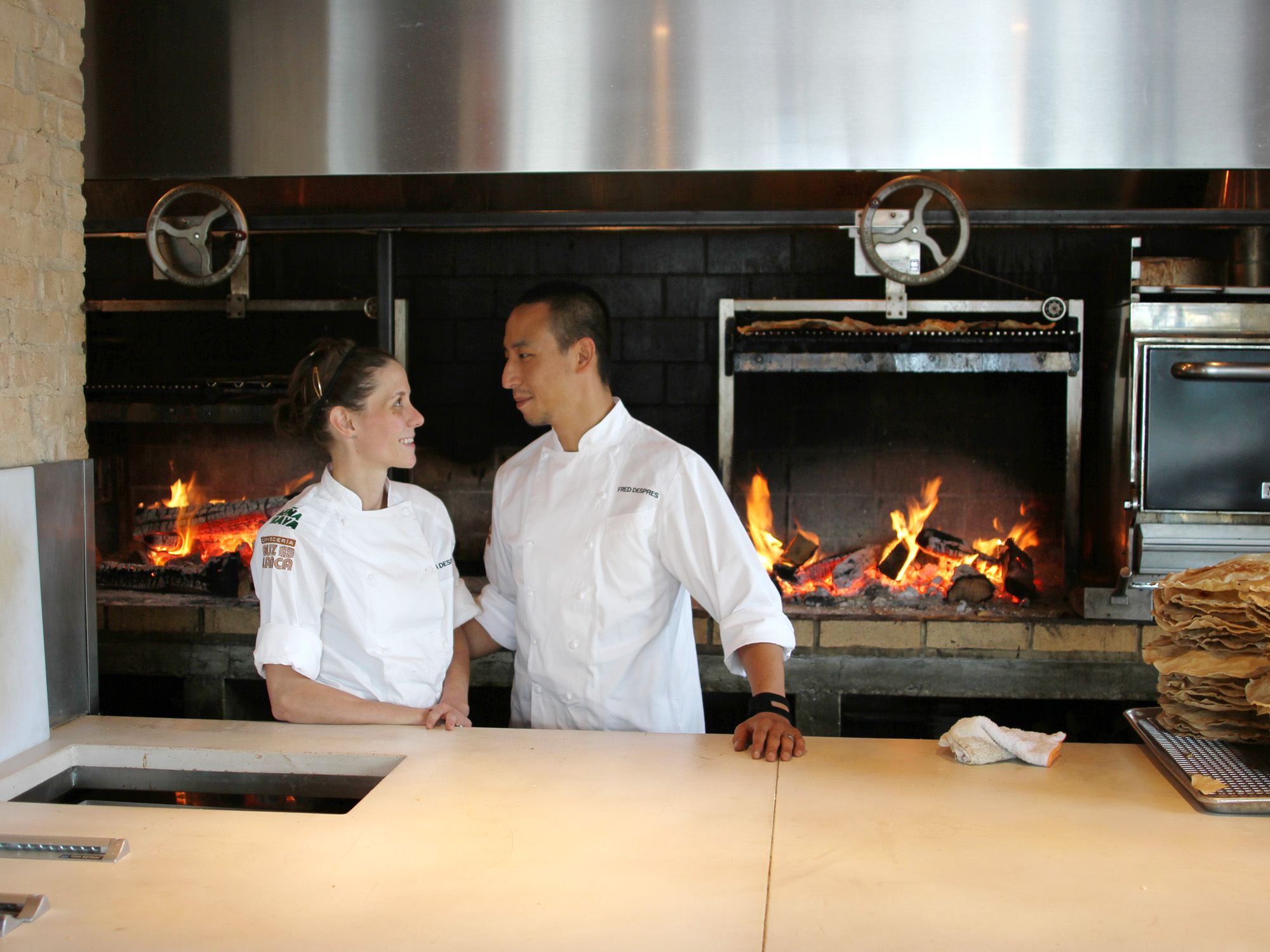I HAVE SOME LONGER, IN-DEPTH INTERVIEWS I need to transcribe, and you’ll be seeing those soon here, but in the meantime I had a chance to just sit down for a few minutes with two really nice people who were about to open their nice restaurant. And so I did.
At that point David Posey, formerly chef de cuisine at Blackbird, and his wife Anna, former pastry chef at The Publican, were just hours from opening Elske, their modestly-proportioned, kind-of-Danish (we’ll get into that) Randolph street restaurant. (I had been to a media preview the night before.) I had to step around some workmen’s tools as I came in, so it should have been hectic as they hurried to be ready for guests.
Yet the Poseys seemed as relaxed as the space, which is, to coin a phrase, Danish modern inside. There’s an open kitchen, with rustic plates and serving pieces made by artist friends for the restaurant. (Anna is herself an artist, and did the illustrations for Dana Cree’s upcoming ice cream book while Elske was in the works.) There’s also, though it’s a little too cold for it right now, a charming little garden with a fireplace and, eventually, fresh herbs growing.
They sat down with me to chat about how they got here, Anna with a pot of green herb tea which glowed in the winter light coming in the front window, David with a big pot of the special Elske blend that Sparrow Coffee worked up for them. Then they made me a couple of items off the menu to take pictures of and to taste, as if they had nothing special going on that day. If they can keep Elske that relaxed and welcoming, it will really be something special.
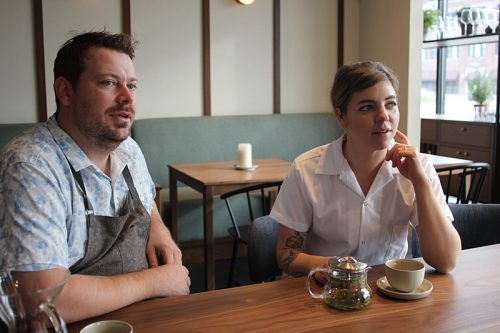
FOODITOR: You’re opening tonight. So why are you wasting time talking to me?
DAVID: We’re planners. We’re good.
So as everyone notes, “elske” is a Danish word meaning love. Which came first—the idea of the restaurant, or the two of you as a couple?
DAVID: Well, I’ve wanted to open a restaurant for fifteen years.
ANNA: I think the name came later. I mean, when I first met you, you were talking about a restaurant.
Is this the restaurant you were thinking about fifteen years ago, or did it evolve along the way?
DAVID: We were actually talking about that this morning. When I had an idea of a restaurant, I wanted to go all out, like Alinea, three star service, linens, everything. But as I grew older—I still enjoy eating that way, but I don’t want to be involved with that every day. I think I just became a little more relaxed, and I think you definitely brought a relaxedness to the situation—it is a hundred percent what we want, though.
ANNA: It’s food that we want to eat, but it’s still creative enough that to make us excited to create it. It’s interesting, but also simple. And I think our travels have really shaped our palates.
People talk about Denmark right now, and in food circles that means Noma, and ants on moss, that kind of thing. What is Danish food, or what is that Danish influence?
ANNA: We kind of got pushed in the Danish category. But food is sentimental, and you grew up with a Danish mom, so it automatically has that sentiment of her cooking, which is Danish. So I don’t think it’s necessarily Danish food—I think my midwestern influence has had a lot to do with it—
DAVID: I’ve always had a hard time grasping the whole Nordic cuisine concept. It doesn’t make sense to me—what makes something Nordic, because you use turnips? They use turnips in Japan. They use turnips everywhere. What makes you Nordic, because you ferment things? China ferments stuff. Korea ferments stuff.
It’s been hard for me to grasp because a lot of people ask, are you serving Danish food? We’re not serving Danish meatballs and potatoes with parsley sauce. We are putting the whitefish toast that we served last night as a kind of smørrebrød snack, and that’s definitely Scandinavian.
ANNA: I think really, as any person’s life does, all of our influences come together for this restaurant. It just feels like… us. All of us has gone into the design, and the food, and every little aspect of it. We’re doing American food, our way. But it is hard because people want that tagline for the restaurant—
DAVID: You’re going to get pigeonholed, somehow.
So when someone dines here, how do you see what their experience is going to be?
DAVID: I think we’re going for creative food in a relaxed atmosphere, at an affordable price point. Something that is relatively new to Chicago, though we certainly have every aspect of that. But it’s difficult to get them all in one place.
ANNA: I think we’re just hoping to have an approachable menu for the cost. And we’re trying to keep the atmosphere pretty playful. Simple, but elegant.
DAVID: I think simple is elegant.
ANNA: Like our neon sign. [The only signage is a neon script “Elske” in the window.] We have a gnome in the garden.
DAVID: David the gnome.
ANNA: It really is named David.
DAVID: She bought a gnome from Europe on like Ebay—
ANNA: Etsy.
DAVID: —and it came with a whole story and it actually is named David the gnome.
It was fate. So what is the approach to food here?
ANNA: I think we both try to be creative but not manipulate it too much. I think in the midwest, you’re not dealt the produce that you have in California, so you have to be that much more creative. But there’s that line between manipulation and—like the carrots last night [a dehydrated carrot and mussels mousse appetizer], you treat it in a way that respects the carrot. It’s still delicious and it still has the chew of a carrot.
I think as any person’s life does, all of our influences come together for this restaurant. It just feels like… us.
The menu’s light, but it’s really thoughtful. The drink menu is thoughtful, it has just four cocktails but they’re all awesome cocktails. There’s gin, rum, there’s a wine-based cocktail, and there’s an amaro cocktail, so it covers all the categories. The wine list is awesome, but not immense. Dessert menu’s pretty concise.
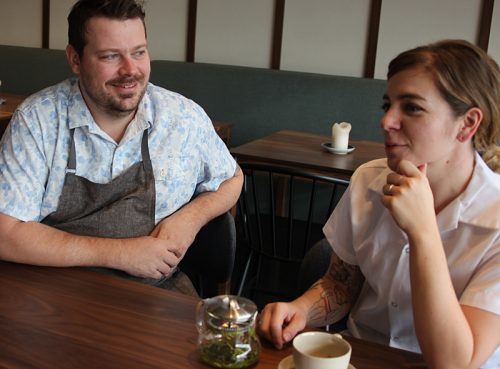
Compared to other restaurants along Randolph, this is pretty small, with a short menu. What made you think people wanted something smaller and more intimate along here?
DAVID: Well, that’s what we want. If you travel all over the country, you see small, intimate restaurants. Chicago is seriously lacking that—we used to have it, and then for some reason everyone decided to open 200-seat restaurants. Which is great, but it’s not what we want. I think as a lifestyle, we don’t want the stress of a 200-seat restaurant.
ANNA: We want to be small, and full. We’re not shooting for awards—we just want people to love the food. And be packed, like our friends at Giant.
I was just wondering that, why didn’t you open on Armitage? That’s where the places like you describe are.
ANNA: We were originally looking over there. We were also looking for a Giant restaurant, as in, Giant the restaurant, not giant sized, in Ukrainian Village. But then David stumbled on this building, and just the idea of having a corner spot, with the garden—yeah, we were going to open an intimate restaurant in Chicago, but with the garden we immediately thought, let’s take it that step further.
How are you going to use the garden? Because it was too cold for anybody to pay much attention to it last night.
ANNA: We’ve had people [at friends and family previews] asking to sit out there, which is awesome. So there’s blankets, and when the fire is going, and you’re already tipsy, it seems like a cocktail by the fire is a good idea.
The beds that are all evergreens right now will be full of herbs. There will be tables and seating out there eventually.
DAVID: Our goal is to not use any of the expensive microgreen companies. Not that there’s anything wrong with them, but we got some garlic, chive flowers in the other day, and one little clamshell of 30 flowers cost fifty bucks. It’s like, we could grow those in the summertime for free… and if we have an abundance of them we could dry them, do something with them. I don’t want to pay for anise hyssop flowers. I want to use them, but I don’t want to pay for them.
I mean, how often do you really cook with herbs at home, because they’re so expensive? If I could all the time I would.
ANNA: I think it’ll be really special for the cooks to be able to take and cut what you need for the night. This will be one of their responsibilities, tend the garden, we’re putting that on their prep lists.
DAVID: It’ll be unreal for a cook in Chicago to be like, go water the flowers and pick what you need for the night, bronze fennel fronds or whatever. There’s not many places in Chicago that can say that.
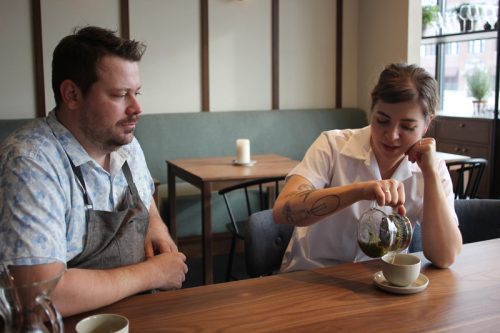
ANNA: And I think that goes back to—we’re going to spend all of our time here. We want this to be a happy place, we want the cooks to be happy. We want them to not be in a windowless kitchen on the 30th floor somewhere, slaving away. I hope people sense the warmth and the happiness when they come in.
David, you came from Blackbird, and Anna came from The Publican—what’s different about the food you’re making here?
DAVID: I think for me it’s pretty similar to what I was doing at Blackbird. I haven’t really changed my thought process. It’s still manipulating flavors and textures in interesting combinations. I’m using the same flavors that I used at Blackbird—I kind of tweaked a couple of dishes that I made there, because I have six new cooks that I’m learning how they work, and it would be unfair to them to do that and be working on all-new dishes at the same time.
But yours is a pretty radical departure from The Publican—
ANNA: I think it’s the food that I always wanted to do. Publican was great because I could easily see what people wanted to eat. Caramel always sold really well, chocolate always sold really well, certain pairings sold well, where other things would weird people out.
Like what?
ANNA: If you had a fennel dessert on at Publican and a chocolate dessert on at Publican, you’re gonna sell five of this one and 40 of that one. You know, I was torn in a million different directions in a good way, and it taught me how to manage time, how to manage a huge department—I had six employees and now I have one.
I’m excited to work on the more artistic, creative side of food—I’ll always love making pies, and I kind of miss that, but I think getting the chance to play with texture and color, work on plates that we’ve designed ourselves with friends. For me as an artist, that’s really interesting. And I can get a little more out there with my desserts, or maybe appreciate vegetables a little more, and it will actually sell.
DAVID: Or put it on a tasting menu and they’re forced to eat it.
ANNA: We’re getting good feedback on my first tasting menu dessert, and it’s unusual, and I don’t think people would order it on the a la carte menu. But the response is Wow, I didn’t even know those flavors would go together. So for me that’s really exciting, how far can I push the envelope. For me it’s also really important to have sentimental notes in my food. I always like it when people say, this reminds me of something from my childhood. Well, it’s not something their grandma ever made, but the flavors are reminiscent of that, like a porridge.
So it’s been really exciting. I’m excited to see where I go. I have a lot to learn, and I have someone backing me who can taste my food, and supports me, and I think we’re a good team.
Gallery: A Short Slideshow of Elske Dishes
Mikael Gebert er redaktør af Fooditor.
Give someone the gift of good restaurants this holiday season—99 of them, in fact. Get The Fooditor 99 at Amazon and for Kindle here.
Latest
Join the Discussion
After you comment, click Post. If you're not already logged in you will be asked to log in or register with Disqus.











